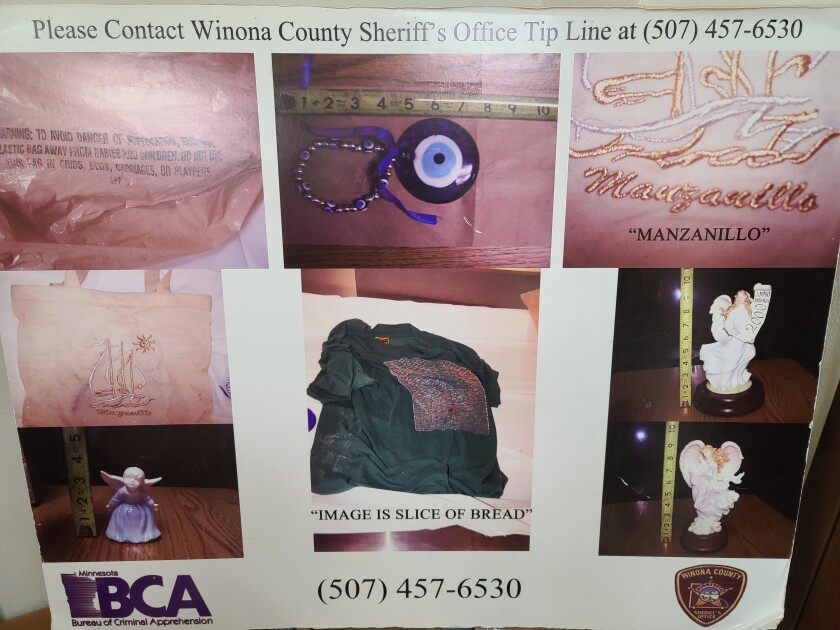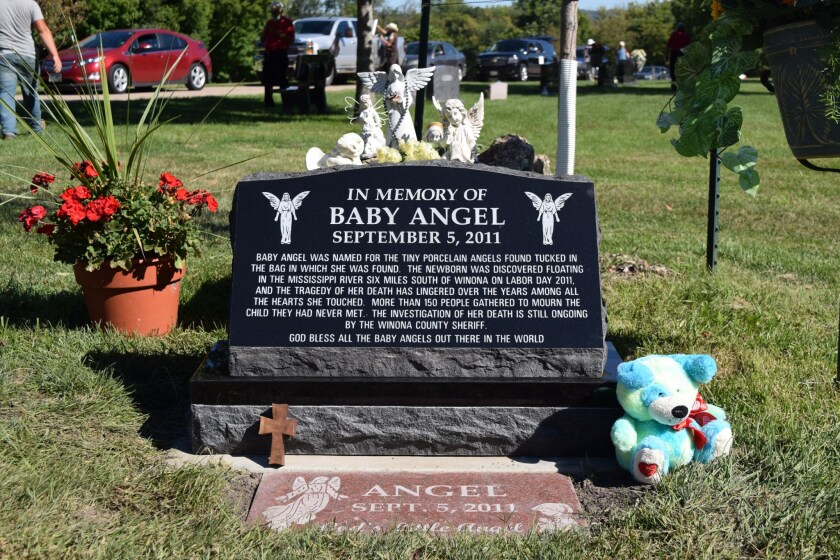WINONA, Minn. — More than 10 years after a days-old infant girl was found in the Winona waters of the Mississippi River, forensic genealogy is leading investigators closer to the child’s identity.
Concealed in a white tote bag, the baby was retrieved from the river by a family of boaters on Sept 5, 2011. While they believed they were picking up trash from the river, what they discovered was something infinitely more precious.
ADVERTISEMENT
A 7-pound baby, seemingly untouched by the circumstances, was concealed in the tote. She was found inside two plastic bags, swaddled under a green t-shirt. Inside the bag, four porcelain angels and a seeing eye bracelet, a symbol of protection, were discovered.

Although her identity is unknown, her death has been mourned throughout the community. Six months after her discovery, more than 150 local residents gathered in Winona’s St. Paul’s Episcopal Church to honor the girl lovingly referred to as Baby Angel. She was laid to rest at Woodlawn Cemetery, where her gravestone stands today.
An autopsy of Baby Angel was not able to determine the cause of death or whether the infant survived childbirth, according to the Winona County Sheriff’s Office. An umbilical cord still intact led investigators to believe she was not delivered in a hospital setting.
At the time of Baby Angel’s discovery, forensic genealogy — also referred to as investigative genetic genealogy — was largely unknown. Law enforcement followed leads associated with the figurines found alongside Baby Angel, but ultimately those paths did not lead to the child’s parents.
Now, with the growing databases related to forensic genealogy, the game is changing — and the true identity of Baby Angel could be on the horizon.
Identifying Baby Angel with forensic genealogy
Winona County Sheriff’s Office Chief Deputy Jeff Mueller told Forum News Service that forensic genealogy is at the heart of the investigation. The Sheriff’s Office is actively working with Parabon, a private organization that assists law enforcement agencies with tools that pair DNA databases with genealogy.
Parabon’s Snapshot Genetic Genealogy is especially useful in identifying human remains. Uploading DNA samples to a database is helpful in determining potential familial matches. However, that picture is painted even clearer when paired with genealogical research tools, including the U.S. census, birth records, death records, obituaries and newspaper archives.
ADVERTISEMENT
In the case of Baby Angel, it’s working.
“It’s a progression. As they receive additional information, we sometimes receive additional information,” Mueller said. “To this day we are still following up on some leads currently with them through some genealogy research and things like that.”
Those leads have been followed up on by the Winona County Sheriff’s Office with the collection of DNA evidence from those identified as potential pieces of the family tree puzzle.
“I rely on them saying, ‘Here’s the person you need to speak with to get us closer to that limb on that tree that we’re trying to get closer to, which is a match to our Baby Angel… or a closer match,” Mueller said.
And they are getting closer. The family tree is growing with each piece of information collected, ultimately leading them closer to Baby Angel.
“Trying to narrow it down to a closer relative is really where we’re at right now,” Mueller said.
How does forensic genealogy work?
Forensic genealogy made headlines in 2018 when the Golden State Killer was arrested through the use of genetic databases and family tree construction. It was the first high-profile case that delved into the data provided by direct-to-consumer genealogy test kits.
ADVERTISEMENT
While direct-to-consumer genetic testing companies — including those owned by Ancestry.com and 23andMe — do not provide data or information to law enforcement agencies, more comprehensive tools — like GEDmatch and Family Tree DNA — do provide users the option to share uploaded DNA data with law enforcement.
As it turns out, a lot of people choose to share DNA data with law enforcement. In 2021, 83 percent of GEDmatch users opted in for law enforcement use of their data, according to the Journal of Law and the Biosciences.
Databases like GEDmatch and Family Tree DNA essentially bring together all the DNA data collected through the various direct-to-consumer genetic testing companies.
If someone were to send their DNA to 23andMe and receive information regarding their genetics and family members, those matches would typically expand when paired with data collected through other direct-to-consumer testing sites like Ancestry.com.
This creates a potential gold mine for law enforcement agencies with DNA on hand — either to solve a crime or to identify a missing person, particularly when paired with modern day genealogy.
Identifying the unidentified
Organizations like Parabon and the DNA Doe Project work with law enforcement on cases of unidentified individuals, relying heavily on genetic databases.
While the DNA Doe Project is not working on the case of Baby Angel, it does work with law enforcement on cases related to unidentified remains. Its formula for solving those cases is similar to other organizations that utilize forensic and genetic genealogy.
ADVERTISEMENT
After collecting the appropriate DNA sample, which is decided by the organization depending on the circumstances of the case, the DNA information from that sample is uploaded to a database like GEDmatch. Often, genetic matches initially indicate a second- or third-cousin, not necessarily a parent or grandparent.

From there, it’s a matter of building out the family tree from past to present day. When it comes to the unidentified remains of adults, the investigation relies on a different set of clues that aren’t necessarily available in the case of an unidentified baby, according to Kevin Lord, director of lab and agency logistics for DNA Doe Project.
In the case of an unidentified adult, registered addresses and work history, for example, could be used as clues to solve a case. However, with infants, investigators would be looking to build out a family tree with a different set of clues, ultimately leading to the parents. In most cases of unidentified babies, special focus is given to identifying the mother.
“It is entirely possible,” Lord said. “Instead of looking for the person when building down in time, the investigation would be looking at the mother or the father who looks to be around the right age, and hopefully someone who would be in the right place at the right time.”
Those are the clues Mueller believes are vital to the investigation.
When asked whether he believes forensic genealogy will be what leads investigators to the truth, Mueller had a very simple answer.
“I do,” he said.









